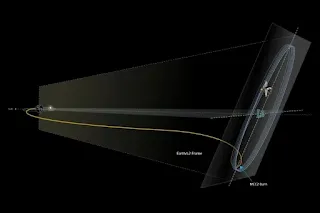After he arrives at his workplace, when will the first images come to us from the James Webb Telescope?
On January 24, the US Space and Aviation Agency (NASA) announced that the James Webb Space Telescope has reached its working point in space, which is located at a distance of about 1.5 million kilometers from Earth on the opposite side of the sun, and that it is now operational.
Within a maximum of 3 months from launch, James Webb will first begin adjusting his 18 gold hexagonal mirrors so that they work together as one, the largest ever in space.
Then, over an additional 3 months, the telescope will begin to take inaccurate images of predetermined groups of stars. These images will not be without scientific purpose, but are additional measures to adjust the telescope in order to work with a specific accuracy.
Six months after its launch, the James Webb Telescope will be able to begin its first mission of the so-called " Business Cycle One " (Cycle 1), a group of 266 research missions selected from researchers in 41 countries around the world (one third of them led by women). The Hubble telescope will spend 6,000 working hours on these missions.
About a third of these tasks will be related to the study of galaxies, and 23% of them will be concerned with planets revolving around stars other than the sun, followed by 12% dedicated to the study of astrophysics of stars, and half of that percentage will be devoted to the study of the solar system.
Biggest tasks
In its largest mission , the James Webb Telescope will give about 209 working hours to one main goal, which is to capture images of thousands of galaxies that arose within a billion years from the moment of the Big Bang, which a telescope has not been able to accurately line up before because of the huge distance between us and them.
These observations could help to understand an essential part of the universe's history known as the "reionization epoch," the period from 400 million to a billion years after the Big Bang, when the first stars and galaxies appeared.
This is followed by a mission related to the study of the atmosphere of a number of planets orbiting other stars, at great distances from the sun, the telescope will spend about 142 hours of work on that mission.
James Webb will be particularly interested in studying the TRAPPIST-1 star system. An international research team had discovered its existence in 2017, and it consists of 7 planets orbiting at very close distances from a type of star called a "red dwarf" that is relatively close to Earth.
James Webb will also devote about 100 hours of work to observing small objects that lie beyond the planet Neptune, and these observations will be particularly interested in searching for compounds such as water, carbon dioxide, or complex organic matter.
The study of these bodies helps reveal the origins of our planet itself, and the rest of the planets. In addition, these data may support the hypothesis that life may have originated in the far reaches of the solar system and then traveled to Earth with a comet or asteroid billions of years ago.



